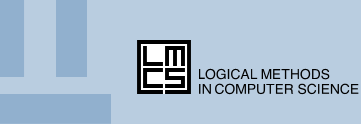 |
 |
Algebra and Coalgebra in Computer Science: CALCO 2009
2009 Editors: Alexander Kurz, Andrzej Tarlecki
1. Relating coalgebraic notions of bisimulation
The theory of coalgebras, for an endofunctor on a category, has been proposed as a general theory of transition systems. We investigate and relate four generalizations of bisimulation to this setting, providing conditions under which the four different generalizations coincide. We study transfinite sequences whose limits are the greatest bisimulations.
2. Symbolic and Asynchronous Semantics via Normalized Coalgebras
The operational semantics of interactive systems is usually described by labeled transition systems. Abstract semantics (that is defined in terms of bisimilarity) is characterized by the final morphism in some category of coalgebras. Since the behaviour of interactive systems is for many reasons infinite, symbolic semantics were introduced as a mean to define smaller, possibly finite, transition systems, by employing symbolic actions and avoiding some sources of infiniteness. Unfortunately, symbolic bisimilarity has a different shape with respect to ordinary bisimilarity, and thus the standard coalgebraic characterization does not work. In this paper, we introduce its coalgebraic models. We will use as motivating examples two asynchronous formalisms: open Petri nets and asynchronous pi-calculus. Indeed, as we have shown in a previous paper, asynchronous bisimilarity can be seen as an instance of symbolic bisimilarity.
3. Being Van Kampen is a universal property
Colimits that satisfy the Van Kampen condition have interesting exactness properties. We show that the elementary presentation of the Van Kampen condition is actually a characterisation of a universal property in the associated bicategory of spans. The main theorem states that Van Kampen cocones are precisely those diagrams in a category that induce bicolimit diagrams in its associated bicategory of spans, provided that the category has pullbacks and enough colimits.
4. Finitely generated free Heyting algebras via Birkhoff duality and coalgebra
Algebras axiomatized entirely by rank 1 axioms are algebras for a functor and thus the free algebras can be obtained by a direct limit process. Dually, the final coalgebras can be obtained by an inverse limit process. In order to explore the limits of this method we look at Heyting algebras which have mixed rank 0-1 axiomatizations. We will see that Heyting algebras are special in that they are almost rank 1 axiomatized and can be handled by a slight variant of the rank 1 coalgebraic methods.
5. Conway games, algebraically and coalgebraically
Using coalgebraic methods, we extend Conway's theory of games to possibly non-terminating, i.e. non-wellfounded games (hypergames). We take the view that a play which goes on forever is a draw, and hence rather than focussing on winning strategies, we focus on non-losing strategies. Hypergames are a fruitful metaphor for non-terminating processes, Conway's sum being similar to shuffling. We develop a theory of hypergames, which extends in a non-trivial way Conway's theory; in particular, we generalize Conway's results on game determinacy and characterization of strategies. Hypergames have a rather interesting theory, already in the case of impartial hypergames, for which we give a compositional semantics, in terms of a generalized Grundy-Sprague function and a system of generalized Nim games. Equivalences and congruences on games and hypergames are discussed. We indicate a number of intriguing directions for future work. We briefly compare hypergames with other notions of games used in computer science.
6. Semantics of Higher-Order Recursion Schemes
Higher-order recursion schemes are recursive equations defining new operations from given ones called "terminals". Every such recursion scheme is proved to have a least interpreted semantics in every Scott's model of \lambda-calculus in which the terminals are interpreted as continuous operations. For the uninterpreted semantics based on infinite \lambda-terms we follow the idea of Fiore, Plotkin and Turi and work in the category of sets in context, which are presheaves on the category of finite sets. Fiore et al showed how to capture the type of variable binding in \lambda-calculus by an endofunctor H\lambda and they explained simultaneous substitution of \lambda-terms by proving that the presheaf of \lambda-terms is an initial H\lambda-monoid. Here we work with the presheaf of rational infinite \lambda-terms and prove that this is an initial iterative H\lambda-monoid. We conclude that every guarded higher-order recursion scheme has a unique uninterpreted solution in this monoid.